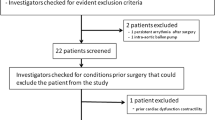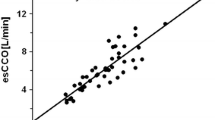Abstract
We developed a noninvasive computer-based system for estimating continuous cardiac output by a modified pulse contour method using a finger pressure waveform. The method requires no individual patient calibration or baseline cardiac output. First, we calibrated the system in a “learn” group of 20 patients. The computer-based cardiac output was then compared with thermodilution cardiac output in 27 patients undergoing coronary artery bypass surgery. A total of 94 cardiac outputs were performed (three averaged per determination) at four predetermined time periods: preinduction, postinduction, prebypass, and postbypass. During determination of each thermodilution cardiac output, the pulse wave data were simultaneously recorded on cassette tape. The patients had cardiac outputs ranging from 2.9 to 6.4 L/min. The correlation coefficient was 0.75. The average thermodilution cardiac output was 4.50 (±0.83 SD) L/min, while the cardiac output derived from the finger pressure wave was 4.48 (±0.7 SD) L/min (95% confidence interval [CI] of difference, 0–3.2%). The mean difference between the two methods was 0.02 (±0.55 SD) L/min. The 95% CI for the bias was 0.0001 to 0.036 L/min. The 95% CI for the lower limit of agreement was − 1.12 to − 1.06 L/min; the upper limit for the 95% CI was 1.09 to 1.16 L/min. The program demonstrated that information about cardiac output can be obtained by using the Finapres device (Ohmeda, Boulder, CO). The cardiac output values obtained by this continuous noninvasive technique were within ±20% of the simultaneous thermodilution values 87% of the time. This was true over the narrow range of cardiac outputs (2.9 to 6.4 L/min) and wide range of heart rates (45 to 140 beats/min).
Similar content being viewed by others
References
Smith NT, Wesseling KH, deWit B. Evaluation of two prototype devices producing noninvasive, pulsatile, calibrated blood pressure measurement from a finger. J Clin Monit 1985;1:17–29
Imholz BPM, van Montfrans GA, Settels JJ, et al. Continuous non-invasive blood pressure monitoring: reliability of FinapresR device during the Valsalva maneuver. Cardiovasc Res 1988;22:390–397
Dorlas JC, Nijboer JA, Butijn WT, et al. Effects of peripheral vasoconstriction on the blood pressure in the finger, measured continuously by a new noninvasive method (the FinapresR). Anesthesiology 1985;62:342–345
van Egmond J, Hasenbos M, Crul JF. Invasive v. noninvasive measurement of arterial pressure. Br J Anaesth 1985;57:434–444
Wesseling RH, Settels JJ, deWit B. The measurement of continuous finger arterial pressure noninvasively in stationary subjects. In: Schmidt TH, Dembroski TM, Blumchen G, eds. Biological and psychological factors in cardiovascular disease. Berlin: Springer-Verlag. 1986:355–375
DeMeersman RE. New noninvasive computerized method for the area measurement of the dicrotic notch. Comput Biol Med 1989;19:189–195
Alicandri C, Fariello R, Boni E, et al. Possibility of cardiac output monitoring from the intra-arterial blood pressure profile. Clin Exp Theory Pract 1984;A7:345–353
Juardo RA, Matucha D, Osborn JJ. Cardiac output estimation by pulse contour methods: validity of their use for monitoring the critically ill patient. Surgery 1973;74:358–369
Milnor WR. Pulsatile pressure and flow. In: Milnor WR, ed. Hemodynamics. Baltimore: Williams & Wilkins, 1989:102–132
Hales S. Statistical essays: containing haemastaticks, vol 2. London: Innys and Manby, 1733. Reprinted: History of Medicine series, Library of New York Academy of Medicine, no. 22. New York: Hafner Publishing, 1964
Frank O. Die Grundform des Arteriellen Pulses. Z Biol 1899;37:483
Liu Z, Brin KP, Yin FCP. Estimation of total arterial compliance: an improved method and evaluation of current methods. Am J Physiol 1986;251:H588-H600
Wesseling KH, deWit B, Weber AP, Smith NT. A simple device for the continuous measurement of cardiac output. Adv Cardiovasc Phys 1983;5:16–52
McDonald DA. Wave reflections. In: McDonald DA, ed. Blood flow in arteries. London: Edward Arnold, 1960:233
Latham RD. Pulse propagation in the systemic arterial tree. In: Westerhof N, Gross DR, eds. Vascular dynamics: physiological perspectives. New York: Plenum, 1989:49–67
Levett JM, Replogle RL. Thermodilution cardiac output: a critical analysis and review of the literature. J Surg Res 1979;27:392–404
O'Rourke MF. The arterial pulse in health and disease. Am Heart J 1971;82:687–702
Bland JM, Altman DG. Statistical methods for assessing agreement between two methods of clinical measurement. Lancet 1986;1:307–310
Hodges M, Downs JB, Mitchell LA. Thermodilution and Fick cardiac index determinations following cardiac surgery. Crit Care Med 1975;3:182–184
Carpenter JP, Nair S, Staw I. Cardiac output determination: thermodilution versus a new computerized Fick method. Crit Care Med 1985;13:576–579
Kurki T, Smith NT, Head N, et al. Noninvasive continuous blood pressure measurement from the finger: optimal measurement conditions and factors affecting reliability. J Clin Monit 1987;3:6–13
Wesseling KH, Settels JJ, van der Hoeven GMA, et al. Effects of peripheral vasoconstriction on the measurement of blood pressure in a finger. Cardiovasc Res 1985;19:139–145
Author information
Authors and Affiliations
Rights and permissions
About this article
Cite this article
Gratz, I., Kraidin, J., Jacobi, A.G. et al. Continuous noninvasive cardiac output as estimated from the pulse contour curve. J Clin Monitor Comput 8, 20–27 (1992). https://doi.org/10.1007/BF01618083
Received:
Revised:
Accepted:
Issue Date:
DOI: https://doi.org/10.1007/BF01618083




